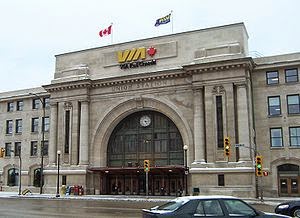roger1818
Senior Member
It was literally just a random dude who writes about trains saying that about 4 seems to be optimal because that's what the Irish use. And then, for some reason, you cut that down to 3.
Since we're going on opinion, I'd say 3-5 is probably about it. It depends on the operating profile of a given route and whether or not unpowered/undriven carriages are included in the consist. For a dozen DMUs out of a Kingston hub? I think DMUs could well be economical up to 4 cars.
First off, DMUs are probably great for the Kingston hub because of the number of stops they are including. Being able to accelerate back to cruising speed quickly is certainly an asset when the route has a stop every 30 km on average. Next, I based my math on your post from Kingston's mayor about 12 trains a day to Toronto and 6 each to Ottawa and Montreal, and assuming reciprocal service at the start of each day.
There are a total of 7 possible stops between Kingston and Toronto, but I wouldn't expect all trains to stop at all of them. Three of them in particular (Port Hope, Trenton Jct, and Napanee) might have more trains stop than today (prior to COVID), but not a lot more (the post from Kingston's mayor says there will be "Express trains to Toronto").
Given that the average trip time of these trains is 2.5 hrs +/- 15 min, with turn around times, a very generous estimate is 3 hrs per run or 6 hrs per roundtrip. That's at least 4-5 trainsets for Toronto-Kingston and 2-3 each for Kingston-Ottawa and Kingston-Montreal. Toss in a spare or two and another for the maintenance pipeline and it's easily in the 12-15 range.
That is almost exactly what I said, if you took the time to actually read my post (5 for Toronto, 2 for Ottawa and 3 for Montreal).
In a world with no spares and no longer term maintenance scheduling.....
I wasn't counting spares as they wouldn't be dedicated for a specific route. Besides, if using the Semmens trainsets, they would already have spares and wouldn't need to buy more (or at least not as many).
Fuel and other running costs (would CN cut a deal for less heavier rolling stock?) are usually much higher than maintenance costs. So the savings from commonality would have to be substantial along with minimal efficiency gains from deploying DMUs for this to be true.
Why do you think CN would "cut a deal for less heavier rolling stock?" Anything VIA puts on the tracks is light compared to what they are hauling. What CN doesn't like is VIA's speed.
Look at how many types VIA has now. In a world where they are down to just Chargers, Venture coaches and a DMU fleet, their operations and workforce would be substantially more streamlined than today. What this is then down to debating is specifically going even further to exactly one model of locomotive and one family of coaches.
I don't think it would be feasible for VIA to only have only "one model of locomotive and one family of coaches" coast to coast, but reducing the number of variations will greatly help reduce maintenance costs. The inventory of spare parts they need to keep would be much smaller and the staff would be much more familiar with the model of vehicle they are working on, knowing all of the ins and outs.





